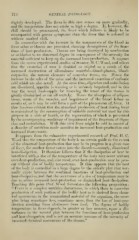Page 704 - My FlipBook
P. 704
714 GENERAL PATHOLOGY. :
slightly developed. The fever in this case comes on more gradually,
and the temperature does not attain so high a degree. If, however, the
chill shoukl be pronounced, the fever which follows is likely to be
accompanied Mith graver symptoms than the fever that is ushered in
Avithout marked chill.
In connection with the increase in the temperature of the blood in
fever other evidences are presented, showing derangement of the func-
tions of heat-production. Tissues are being destroyed by combustion
or oxidation to an abnormal degree in consequence of the necessity for
material sufficient to keep up the increased heat-jH'oduction. It appears
from the recent experimental studies of Senator, H. C. AVood, and others
that the excretion of urea is doubled or tripled as a result of the
increased destruction of all)uminous material—blood-plasma, blood-
corjiuscles, the sarcose elements of muscular tissue, etc. Hence the
increase in the salts of the urine and the increased excretion of carbonic
acid which are also noted. At the same time, digestion and assimilation
are disordered, appetite is wanting or is seriously impaired, and in this
way the usual food-supply for renewing the waste of the tissues is
greatly diminished or cut otf entirely. Hence the absorption of adipose
tissue, waste of the muscles, and impairment of the blood ibllow as
results of, or it may be said form a part of the phenomena of, fever. It
thus becomes evident that the abnoi'mal production of heat during fever
is maintained by the consumption of valuable material not used for this
purpose in a state of health, or the regeneration of which is prevented
by the accompanying conditions of impairment of the functions of diges-
tion and assimilation. With this view fever might be said to consist of
a disorder of nutrition made manifest in increased heat-production and
increased tissue-waste.
It appears from the exhaustive experimental research of Prof H. C
Wood that the temperature of the body is no certain guide to the extent
of the abnormal heat-production that maybe in progress in a given case
of fever, for another factor enters into the disorder—namely, disordered
heat-dissipation. It therefore follows that if the dissipation of heat be
interfered with, a rise of the temperature of the body may occur M'ithout
over-heat-production, and, vice vcrsd, over-heat-production may be pres-
ent without rise of bodily temperature. It thus appears that the heat
of the body is controlled in a large degree by the orderly jilay that nor-
mally exists l)etween the combined functions of heat-production and
heat-dissij)ati()n, and that the occurrence of a rise of temperature may be
due to either increased heat-production or diminished heat-dissipation.
Touching this point Prof. Wood formulates the following proposition
" Fever is a complex nutritive disturbance, in which there is excessive
production of such ])ortion of the bodily heat as is derived from chem-
ical movements in the accunudatcd material of the organism, the over-
])lus being sometimes less, sometimes more, than the loss of heat-pro-
duction resulting from abstinence from food. The degree of bodily
tem])erature in fever depends, in greater or less measure, upon a dis-
turbance in tlie natural play between the functions of heat-production
and heat-dissipation, and is not an accurate measure of the intensity of
increased chemical movements of the tissues."


